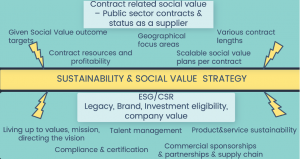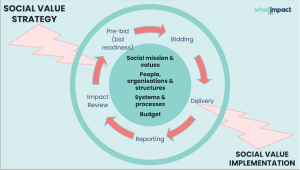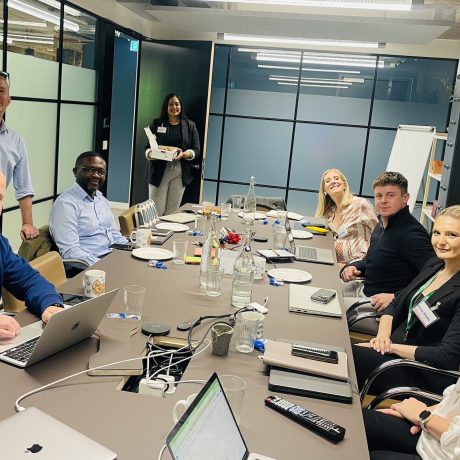This is a 6 part blog series on strategising, planning, budgeting, and implementing social value. The aim is to present the key principles of efficient, meaningful and commercially viable social value delivery.
Social value begins with strategy. Creating a strategy is a challenging task – social value is a complex and relatively new concept in business structures. The process of setting up a social value strategy, however, should not stop your company from committing to tangible action right now: you will never be completely ‘ready’, only better equipped.
whatimpact proposes an agile approach to interactively strategise and make real-life commitments because the social value is, and should be, integrated into everything your company does. Instead of perfecting your strategy and waiting to act, we advise that you implement your strategy as soon as possible to understand its real-life impact. This learning process will inform your future social value activities, thus bringing you closer to a suitable strategy. This means that measuring and reporting on impact is a crucial part of strategic decision-making.
Social value strategy
Your company may already have independent sustainability practices in place, a corporate social responsibility approach or a chosen framework to follow such as ESG, or UN SDGs, which are good starting points for procurement-related social value strategy. It is important that government contract-related social value activities stem from your overall sustainability strategy, but that they do not overlook the significance of them being ‘contract specific’ and ‘locally relevant’.
With this in mind, each tender is going to be different. The Government-generated Social Value Model defines societal challenges in the UK that need attention as, for example, focus areas, themes, award criteria and/or outcomes. The widely used TOMs framework lists similar themes but has much stricter measures with cost-benefit calculations. Each tender is going to be focused on different targets, and a successful social value strategy is one where you match these targets to your company’s social mission, capabilities and areas of operation. This is how the marriage of your overall social value strategy and procurement-related additional activities can thrive – building a coherent social value approach.
The figure above highlights the connection between social value strategy and tender-related social value contributions. The motivations and approaches to deliver vary and can confuse if not acknowledged. The simplest example is how volunteering programmes are managed: The employee engagement perspective suggests that employees can freely choose where and when they wish to volunteer, but from a contract management point of view, the location, cause and type of contribution have to meet the tender criteria.
Harnessing company resources with contract profitability in mind
The key questions to address when harnessing resources while keeping profitability in mind are:
- To achieve tangible goals and make a difference, what are the resources and capabilities that will add value to the contract?
- What kind of employment practices and allocations could you consider to add value?
- What is the budget frame for tender-related social value?
- When you partner with local community organisations or find socially relevant suppliers, how and with what resources will you approach them?
Resources are not only your external contributions such as donations (money, services, products), volunteering (non-skilled or skilled-based), and harnessing buying power for good (commercial partnerships with social value organisations) but how you manage social value internally and what kind of labour and system costs they entail.
It is good to keep in mind that tender-related budgets are provisional. Contributions are only activated if your company wins a particular bid, which again defines the geographical location of social value delivery and the focus of social value activities.
Necessary certificates and standards to become bid-ready
Make sure you have industry-related and basic certifications and standards in check, these create the starting point for building up added-value practices and activities.
Impact, legacy, continuity
Social Value means making a lasting impact; you should consider the impact you wish to leave behind after the contract has ended. How can you make sure your resources do not only improve the conditions while you are working in the local area but continue to have a positive influence after the contract has finished? Partnership models and making local area initiatives stronger through strategic and financial help are powerful ways to build a strong legacy.
Social value implementation
Social value is particularly challenging because it requires wide, cross-department collaboration. The usual social value cycle contains various stages, ranging from bid readiness to bidding to delivery and finally impact reporting and reviewing. These different phases are often completed by different parts of the business, therefore, coordination is key.
It should be clear throughout the process who is responsible for which areas and that decisions and strategies are effectively communicated between the different players. This is best achieved by centralising communication about the different aspects of social value. That way, when bid writers draft social value plans for bids, they can collaborate with those responsible for delivery and have access to information on the success and failures of past plans. The teams collaborating usually consist of HR coordinating volunteers, Social Value Managers managing grants and other donation programmes, and sales departments with bid writers and the commercial objectives of tenders.







